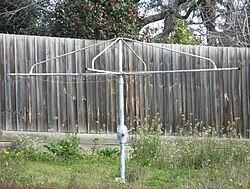Hills Hoist



A Hills Hoist is a height-adjustable rotary clothes line, designed to permit the compact hanging of wet clothes so that their maximum area can be exposed for wind drying by rotation.
The Hills Hoist has been manufactured in Adelaide, South Australia by Lance Hill since 1945. The Hills Hoist and similar rotary clothes hoists remain a common fixture in many backyards in Australia and New Zealand. They are considered one of Australia's most recognisable icons, and are used frequently by artists as a metaphor for Australian suburbia in the 1950s and 1960s.[1] Although originally a product name, the term "Hills Hoist" became synonymous with rotary clothes hoists in general, throughout Australia.
As early as 1895 Colin Stewart and Allan Harley of Sun Foundry in Adelaide applied for a patent for an 'Improved Rotary and Tilting Clothes Drying Rack'. In their design the upper clothes line frame tilted to allow access to the hanging lines.[2] Gilbert Toyne of Geelong patented four rotary clothes hoists designs between 1911 and 1946. Toyne's first patented clothes hoist was sold through the Aeroplane Clothes Hoist Company established in 1911.[3] It was Toyne's 1925 all-metal model (Australian Patent No. 24553/25) with its enclosed crown wheel-and-pinion winding mechanism that defined clothes hoist designs for decades to follow.[4][5]
Lance Hill began to manufacture the Hills rotary clothes hoist in his backyard in 1945. His wife apparently wanted an inexpensive replacement to the line and prop she had for drying clothes, as she had no room on the line due to her growing lemon tree.[6][7]
Lance Hill's brother-in-law Harold Ling returned from the war and joined him to form a partnership in 1946. Ling became the key figure in expanding the production and marketing of the Hills Hoists. In 1947 Hills Hoists began manufacturing a wind-up clothes hoist which was identical to Gilbert Toyne's expired 1925 patent with the crown wheel-and-pinion winding mechanism.[8][9] Initially the clothes hoists were constructed and sold from Lance Hill's home on Bevington Road, Glenunga.[10] Soon production moved to a nearby site on Glen Osmond Road and within a decade the factory had relocated to a larger site at Edwardstown.[8] The company Hills Hoists became Hills Industries in 1958.
A Darwin family reported that the only thing left standing after Cyclone Tracy was their Hills Hoist.[11] The Hills Hoist is listed as a National Treasure by the National Library of Australia.[12] In January 2017, Hills Industries sold the manufacturing and sale rights of its Hills Home Living brands to AMES Australasia,[13] a subsidiary of the American Griffon Corporation.[14]
See also
References
- ^ George Negus on ABC Transcript from 17/2/03
- ^ Rotary and Tilting Clothes Drying Rack National Archives of Australia: Accessed 3/6/2011
- ^ Aeroplane Clothes Hoist Company leaflet State Library of Victoria: Accessed 3/6/2011
- ^ Gilbert Toyne's 1925 rotary clothes hoist patent IP Australia: Accessed 3/6/2011
- ^ Toyne's All Metal Rotary Clothes Hoist, The Canberra Times advertisement, published 12/01/1931
- ^ Harris, D.(1996) What a line! The story of the people who made the hoist an Australian icon: fifty years of Hills
- ^ Hills Hoist, inventors.about.com, accessed 18/1/07
- ^ a b Cuffley, P. & Middlemis, C. (2009) Hung Out to Dry: Gilbert Toyne's classic Australia clothes hoist
- ^ The Hills Story Pandora.com, Accessed 18/1/07
- ^ Hills Hoists early advertisement Trove, Digitised newspapers: Accessed 3/6/2011
- ^ "The Hills Hoist". National Library of Australia. Retrieved 24 January 2015.
- ^ [1] National Library of Australia, Accessed 07/11/2016
- ^ "Hills sells right to make and sell Hills Hoist clotheslines". Sydney Morning Herald. Retrieved 10 January 2017.
- ^ "Hills Ltd sells intellectual rights on clothesline and other products to local arm of US-based Griffon Corporation". Herald Sun. Retrieved 10 January 2017.
External links
- Hills Holdings Australia Parent Company
- Greener Garden Solutions Hills sole appointed official distributor for the UK & Europe
- Lifestyle Clotheslines Hills appointed official online distributor for Australia
